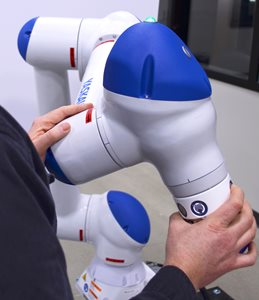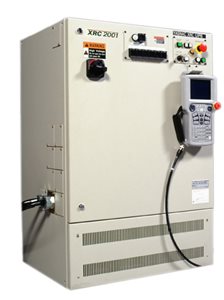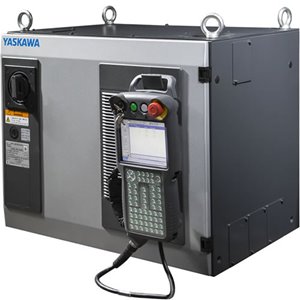Changing consumer dynamics – combined with escalating competitive pressures – are urging company leaders to reassess factory operations, take preventative measures and pursue growth opportunities to optimize production. As a result, upgrades to robots and subsequent peripherals are made by robot makers, but for many manufacturers, the signs for why and when to upgrade said robots may be less clear. Here are a few considerations for upgrading robotic technology:
Reasons for an Upgrade
Part Unavailability
The older the robot, chances are the more difficult it will be to find replacement parts from the robot manufacturer. With new generation robots being released every couple of years, storage space for older model parts can be scarce. While robots are highly reliable and built to last 15
+ years (with the proper maintenance schedule), they will not last forever. Eventually, parts will need phased out and replaced. For this reason, it is always a good idea to keep in contact with your robot brand regional sales manager, as he or she can easily inform you what the part availability is for the manufacturer and model of the robot.
Next-Generation Improvements
Advancements in technology inspire robot OEMs to create next-generation robots and peripherals that enhance application capabilities, optimizing production. From intelligent
touchscreen teach pendants with built-in technology for eliminating the use of conventional coordinate (X, Y, Z) frames, to faster robots with increased axis composite speed for faster cycle times, robotic engineers work hard to discover new ways of providing quick implementation of a robot system, as well as improving product throughput and quality.
For welding applications, new digital weld interfaces for next-generation robot teach pendants are enabling easy tracking of conforming vs. non-conforming parts, setting processes to programs from the pendants and more. These features will decrease programming and cycle time, while also minimizing downtime.
Device Compatibility
Something to keep in mind with next-generation technologies, such as
intuitive teach pendants, digital weld interfaces and machine vision systems, is that they are usually only compatible with newer generation robot models and controllers. In some cases, third-party peripherals may require additional computer power or ladder scanning performance to work properly. Therefore, manufacturers looking to gain competitive edge with the smartest and fastest technology should be mindful of all the items that may need upgraded before new tech can effectively be used.
Unattained Benefits
Recent years have ushered in industrial networking advancements that have effectively shifted the market from using analog weld interfaces to digital weld interfaces – as the connection and interaction between an industrial robot, the welding hardware and a robot operator is made more successful through a reliable and
feature-rich weld interface. However, some companies are still using analog welders, and they are missing out on a large set of benefits, including the management of higher-level process information directly from the robot teach pendant.
Safety Standards
Sometimes, complying with new safety standards will dictate a manufacturer’s decision to upgrade a robotic system. For example, when a Functional Safety Unit (FSU) is required, an upgrade to a next-generation controller may be required to support FSU technology. While most changes to standards are grandfathered in with your previous machinery, there is no price anyone can put on the safety of your employees, especially when new safety features are introduced and can be implemented with a new system.
Programming Needs
More customized than ever, consumer demands are prompting

manufacturers to look for unique ways to reduce integration time or reprogramming downtime. Thanks to Industry 4.0 and the introduction of smart technologies, the use of unique programming methods can facilitate these goals. From programming pendant motion to hand-guiding, and from dynamic pendant motion to offline programming software suites (and every method between), there are multiple programming solutions available to address programming preferences and complexity.
Similarly, the growing worker shortage is prompting manufacturers to think outside the box, hiring workers with limited robot programming knowledge to operate robots on the factory floor. This has prompted increased focus on “ease of use” for new robotic equipment, including programming. And, as mentioned, this is made possible through the use of next-generation robots equipped with intuitive teach pendants that reduce the robotic learning curve by eliminating a worker’s need to have knowledge of the “right hand rule” – which entails the programmer knowing his or her orientation to the robot relative to the frame of operation.
Suggestions for an Upgrade
Sometimes, the questions for upgrading may not revolve around things like part unavailability or safety standards, but rather, the main question may center around the
Yaskawa robot controller.
XRC Controller
Big improvements have been made since the release of the XRC controller.

While programming, troubleshooting and repairs for these controllers are still supported by
Yaskawa Support Services (YSS), parts will eventually be phased out. If your robot currently uses an XRC, an upgrade is highly suggested.
NX100 Controller
While still a solid controller that is well supported by YSS, the NX100 controller does not offer as many options as next-generation controllers when it comes to high-speed communication or machine vision. For manufacturers looking to build competitive edge, an upgrade to a later-generation controller that can accommodate newer technologies may be in order.
DX100 Controller
Supported by YSS for the life of the robot, the DX100 controller generation is very stable, there should be no great rush to upgrade. However, if a Functional Safety Unit is required, an upgrade is recommended.
DX200 Controller
Also supported by YSS for the life of the robot, the DX200 has options, such as easy integration of FSU and preventative maintenance tracking information. DX200 is widely used, and no upgrade is suggested at this time.
YRC1000 Controller
The newest generation of Yaskawa controllers, YRC controllers are

supported by YSS for the life of the robot, and they are found on recently released robots: GP Series, PH Series, AR Series, SP Series and HC Series. The new controller is substantially smaller, and it adds features such as faster ladder scanning time, 380-480 VAC chopper circuit for standardized global power, standard EtherNet/IP, and added preventative maintenance tools. The programming pendant is also more lightweight and ergonomic, while adding features like 3D robot model and detailed alarm information.
Scheduling for an Upgrade
Before scheduling, it is important to decide whether the entire workcell should be replaced, or
if the robots should be retrofitted. Also, determine if the robots and workcells are being repurposed, refurbished or sold.
Because production downtime can be costly, many manufacturers schedule upgrades to be performed over a
“holiday” shutdown, so that the skeleton crew can perform the needed robot upgrades, preventative maintenance and process improvements while most workers are on break. Regardless, if the upgrade is scheduled during a holiday or not, the approach should be the same: specific goals with achievable steps should be communicated to all parties in advance, along with a detailed logistical workflow.
Note: If any external contractors are required, they should be scheduled six to eight months in advance. When in doubt, talk to your Yaskawa sales or service contact to get an expert analysis on your individual situation.